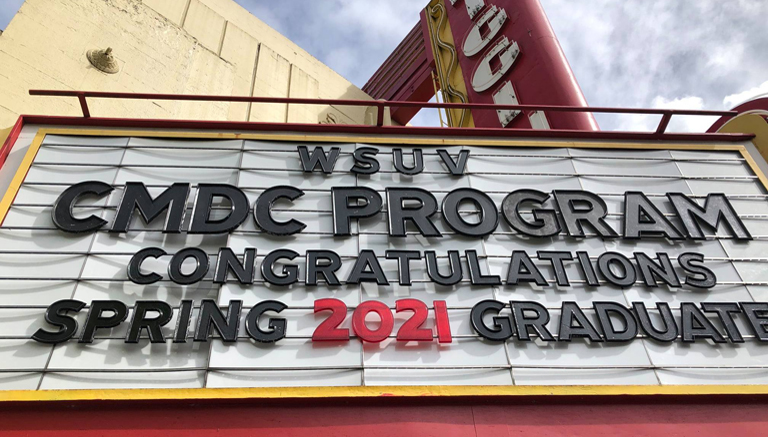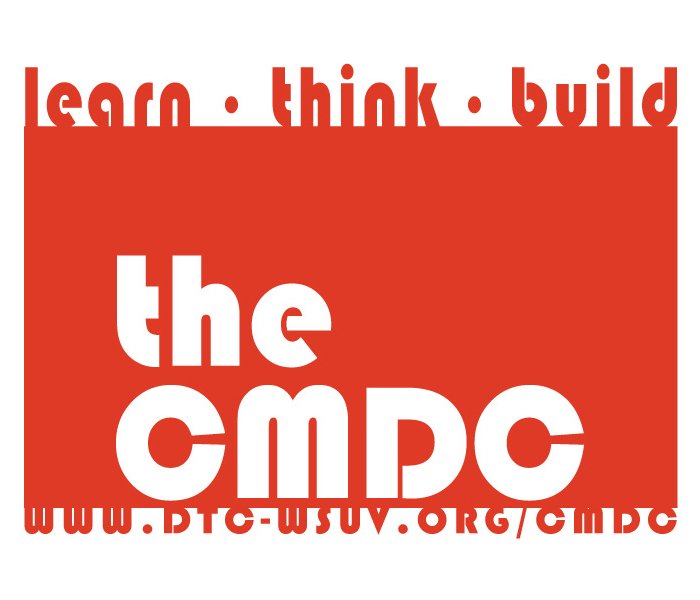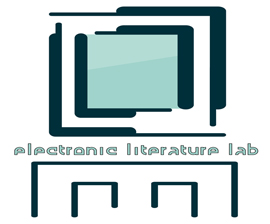Our Approach

Our Approach to Education
We talk in terms of "Superpowers" and believe everyone has at least one. The faculty’s approach is to help students identify their superpowers and encourage the development of them so that when students graduate from the CMDC Program, they are able to excel in their lives and careers and be good citizens of the world.
The CMDC’s Goals and Objectives help to achieve this mission. They are aligned with WSU's Learning Goals and Outcomes (SLOs), as well as courses in the DTC curriculum. Our Standards of Excellence foster student success.
Ten Goals & Objectives
Goal 1: Demonstrate competency with computers for designing, distributing, researching, retrieving, and preserving digital works in various mediums for humane and effective human-computer interactions
- A. Produce web pages and other digital interfaces and/or environments for effective and functional human-computer interactions
- B. Apply Hypertext Markup Language (HTML) and Cascading Style Sheets (CSS) to hand-coded web pages
- C. Employ web and other digital interfaces and/or environments that respond to specific audience needs, as well as usability and accessibility issues
- D. Learn various methods of researching for online information, such as databases, wikis, and websites, and of evaluating its credibility
Aligned to:
- SLOs: Creative & Critical Thinking; Information Literacy; Depth, Breadth, & Integration of Learning
- DTC Courses: DTC 201, DTC 335, DTC 336, DTC 355, DTC 356, DTC 435, DTC 477, DTC 478, DTC 497
Goal 2: Synthesize media forms for multimedia contexts
- A. Organize multimedia for web pages and other digital interfaces and/or environments using various graphics, sound, and video authoring tools
- B. Develop a multimedia project that incorporates various media objects, such as video, animation, sound, and still images
Aligned to:
- SLOs: Creative & Critical Thinking; Information Literacy; Communication; Depth, Breadth, & Integration of Learning
- DTC Courses: DTC 201, DTC 335, DTC 354, DTC 355, DTC 435, DTC 477, DTC 497
Goal 3: Employ the principles for sophisticated manipulation of various forms of digital media
- A. Practice visual fundamentals such as composition, figure/ground relationships, rhythm, contrast, and color
- B. Create and compare print and screen based media, understanding the affordances and constraints of each in the production of visual, sonic, haptic, kinetic, and kinesthetic elements
- C. Create and arrange images and other content in sequence and in non-linear form, demonstrating the conceptual underpinnings of the digital image and its application to time-based media
- D. Utilize textual content as visual rhetoric in the process of designing interactive media interfaces that are both functional and usable
Aligned to:
- SLOs: Creative & Critical Thinking; Information Literacy; Communication
- DTC Courses: DTC 201, DTC 335, DTC 336, DTC 354, DTC 435
Goal 4: Understand the production and assessment of media objects
- A. Understand basics of front end design as well as composition strategies for digital texts and environments
- B. Demonstrate an overall understanding and utilization of appropriate textual content for various forms of interactive media
- C. Produce and evaluate effective textual content that promotes interaction, functionality, and usability by different readers and needs
Aligned to:
- SLOs: Creative & Critical Thinking; Information Literacy
- DTC Courses: DTC 201, DTC 335, DTC 336, DTC 354, DTC 355, DTC 435, DTC 477, DTC 497, DTC 478
Goal 5: Know the basics of information architecture and knowledge management along with ways digital information can be structured for retrieval and archival purposes for different audiences
- A. Examine the structure and culture of the disciplines, publishing cycles, and information flows control access to information
- B. Demonstrate an understanding of how storage and retrieval systems control what information can be found
- C. Use a variety of advanced techniques, such as Boolean searching, subject/descriptor searching, truncation, and proximity, to retrieve information effectively from a variety of electronic information retrieval systems, like subscription databases and the Web
- D. Understand the use of language and vocabulary in information retrieval by exploring thesauri, indexes, concordances, and keyword-matching, as well as demonstrate comprehension of the differences, uses, and strengths of these various ways of using language to retrieve electronic information
Aligned to:
- SLOs: Creative & Critical Thinking; Information Literacy
- DTC Courses: DTC 101, DTC 356, DTC 497
Goal 6: Question the way digital media functions in multiple cultural contexts
- A. Examine the presentation of race, class, gender, and disabilities in digital media
- B. Interpret images found on the web from a cultural context different from your own
Aligned to:
- SLOs: Diversity
- DTC Courses: DTC 101, DTC 475, DTC 497
Goal 7: Recognize various forms of language processing and their implications for media authoring
- A. Use digital media terminology and concepts, such as medium, media, multimedia, mass media, remediation, repurposing, translation, text, textuality, language, and code, appropriately in presentations and projects
- B. Employ various types of texts, such as visual, auditory, kinetic, and kinesthetic texts, for appropriate mediums
- C. Illustrate the way artificial systems acquire language
- D. Demonstrate knowledge about the process by which is language is made via computers
- E. Study, create, and critique digital text and its central role in human-computer interactions
- F. Employ textual content in web pages and other digital interfaces or environments that respond to specific audience needs
Aligned to:
- SLOs: Creative & Critical Thinking; Information Literacy
- DTC Courses: DTC 101, DTC 336, DTC 354, DTC 375, DTC 497
Goal 8: Appreciate the history of technological development, from local to global perspectives, and its implications for a variety of mediums
- A. Demonstrate understanding between digital and analog technologies
- B. Compare and contrast technological development from a historical perspective
- C. Explain contributions of pioneers working in the US and beyond in the area of digital technology
- D. Discuss technologies of oral and written discourse, such as the importance of memory, the development of alphabets, invention of writing tools, and innovations for electronic devices
- E. Examine the way in which metaphors from print culture influence electronic information retrieval systems
Aligned to:
- SLOs: Information Literacy; Depth, Breadth, & Integration of Learning
- DTC Courses: DTC 101, DTC 375, DTC 476, DTC 497
Goal 9: Utilize an interdisciplinary perspective in order to understand the basics of social, economic, and education changes brought about by digital media
- A. Demonstrate knowledge of “digital divide” by explaining the various factors leading to it in the US and beyond
- B. Sketch an activity, program, or event that aims to assist marginalized populations with gaining access and understanding of digital media
- C. Write a cultural critique of media objects that looks at political economy, content, and audience reception of media objects
- D. Discuss “authority,” and the way information is and has been validated; interrogate the role of culture and technology in determining the validity and authority of information
- E. Note the way in which public policies impact access to information
- F. Create, and use information ethically
Aligned to:
- SLOs: Scientific Literacy; Diversity
- DTC Courses: DTC 101, DTC 475, DTC 497
Goal 10: Be practiced and capable communicators in all mediums
- A. Create a digital text in a variety of mediums
- B. Construct and deliver an argument focusing on the way the medium affects the message, audience, and other rhetorical components
- C. Evaluate the effective use of language in a digital text
Aligned to:
- SLOs: Information Literacy; Communication
- DTC Courses: DTC 101, DTC 201, DTC 335, DTC 354, DTC 355, DTC 356, DTC 375, DTC 475, DTC 477, DTC 478, DTC 497
Five Standards of Excellence
1. Envision, imagine and invent digital media objects that do not yet exist in the world and, in creating them, understand the importance to reflect upon their potential impact upon the people and cultures for which they are made and by which they will be used
2. Engage in the rigorous examination of assumptions and values about the self, others, and the world in order to advance knowledge and promote wisdom for bettering the environment and human condition
3. Communicate ideas and viewpoints clearly, elegantly, and creatively with a variety of technologies and modes of expression
4. Delight in discovery and experimentation, recognizing that leadership in innovation demands courage and curiosity and requires an understanding of many forms of and approaches to knowledge
5. Place civic engagement and service to the community at the heart of creation and innovation
View a teaser animation made by one of our students!

 Multimedia Classroom
Multimedia Classroom MakerSpace
MakerSpace Electronic Literature Lab
Electronic Literature Lab MOVE Lab
MOVE Lab

